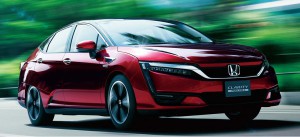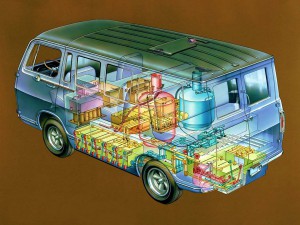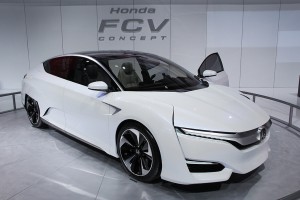
Honda's new Clarity fuel-cell vehicle is part of an onslaught of the vehicles that have hit U.S. roads in the last 18 months.
We’re not quite sure how it managed to nearly slip by us, but we’re coming up on National Hydrogen and Fuel-Cell Day. October 8th has been designated a day to promote awareness of this clean and green powertrain technology.
There are plenty of folks who believe hydrogen is the fuel of the future. And they can point to the small but growing number of vehicles that use the lightweight gas. In the coming weeks, Honda will launch its Clarity FCV to become the third fuel-cell maker on the U.S. market.
Of course, not everyone is so optimistic. Elon Musk, the founder and CEO of Tesla Motors, calls them “fool cells.” Of course, he wants to sell you a battery-powered car, instead. Who is right?
First, a little bit of background: the fuel-cell was invented way back in 1838 by Welsh scientist William Grove. At its most basic, a fuel-cell stack combines hydrogen and oxygen to produce water vapor and an electric current.
The first practical application came with the Apollo lunar mission, providing power for astronauts on the way to the moon.

General Motors introduced a fuel-cell van decades ago and the inner works filled up most of the van.
Then, 50 years ago, General Motors crammed a fuel-cell system into the back of one of its vans. More accurately, it took over almost the entire van, leaving just enough room for a driver and two passengers.
“We had three shifts of people on this project starting in January 1966 and finishing 10 months later,” recalls Floyd Wyczalek. Now 91, he was project manager of Electrovan fuel cell development and had a team of 200 working to make the concept a reality.
(California mandate expected to grow EV sales. For more, Click Here.)
GM put the technology on the back burner for the next 30-some years, only getting serious about hydrogen power again in the 1990s. By then, other automakers had begun to explore the concept, driven by factors including new emissions and mileage regulations.
Nearly a decade ago, Honda became the first manufacturer to actually put a fuel-cell vehicle, or FCV, on the road with a paying customer behind the wheel, the maker’s global president and CEO at the time, Tetsuo Iwamura, calling the FCX Clarity “a shining symbol of the progress we’ve made with fuel-cell vehicles and of our belief in the promise of this technology.”
Only a few hundred were leased worldwide, however, and in the U.S., distribution was limited to a small grid in Southern California where a handful of hydrogen pumps were available.
And the situation hasn’t changed much. Honda remains bullish about the technology, Steve Center, vice president of the Environmental Business Development Office at American Honda Motor Co., declaring that “believes that hydrogen can play a critical role in addressing global climate change and accelerating progress toward a more sustainable, ultra-low-carbon mobility future.”
But when the new Clarity Fuel Cell Sedan comes to market before year-end, it will still be available only in a few select locations where customers could top off their tanks. That’s the same restriction that those interested in the new Toyota Mirai and the Hyundai Tucson Fuel-Cell Vehicle face.
(To see more about the GM, U.S. Army and their Colorado fuel-cell truck, Click Here.)
That said, California regulators have set aside funding to create a statewide hydrogen distribution network and several other states hope to make similar moves – as do Japan, South Korea and Germany.
Meanwhile, today’s new fuel-cell vehicles offer both better range, improved performance – and substantially more interior space – than the old GM Electrovan.
The latest fuel-cell stacks have been downsized to the point they can easily fit under the hood of a compact car. They put out far more power, especially when used in a hybrid configuration, with a battery to aid at launch or when passing.
Meanwhile, higher compression tanks allow the latest FCVs to get as much as 300 miles of range. And unlike the hours it can take to recharge a battery, topping off a hydrogen tank is usually a five-minute affair, in line with putting gas in a conventional vehicle’s tank.
More and more automakers have announced plans to go from concept to production with hydrogen power, from mainstream brands to up-market ones like Mercedes-Benz.
“This could be a ‘now or never’ situation for (FCVs) in mass market mobility,” said Ben Scott a senior IHS analyst. A study released in May by the consulting firm said that the simultaneous launch of more vehicles and the addition of refueling stations will be critical to gain consumer acceptance. If that doesn’t happen over the next decade, it probably never will, the authors concluded.
(Novel Nissan approach could solve problem of hydrogen availability. Click Here for the story.)
Oh, by the way, if you are wondering why National Hydrogen and Fuel-Cell Day is celebrated on October 8th, think of it as geek humor. The atomic weight of the simplest element, it turns out, is 1.008.


Be sure to check out http://www.hydrogenandfuelcellday.org for more activities and events!